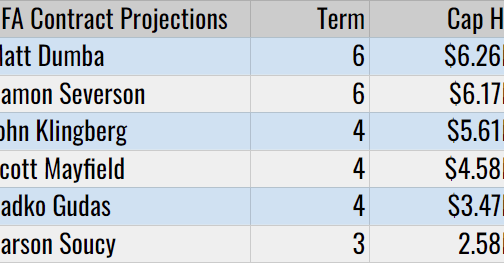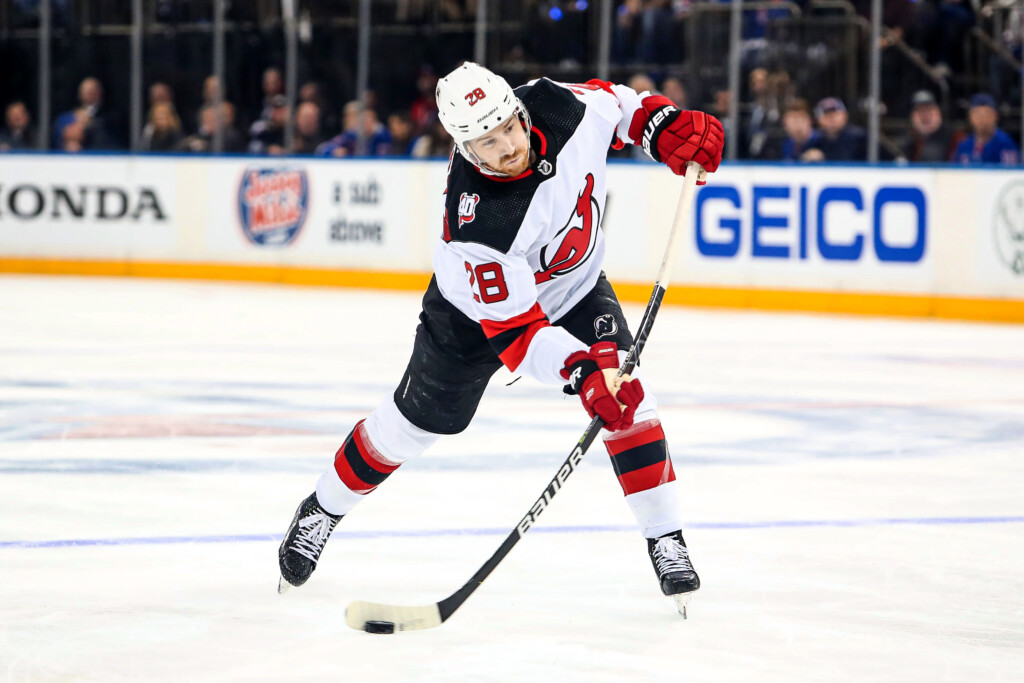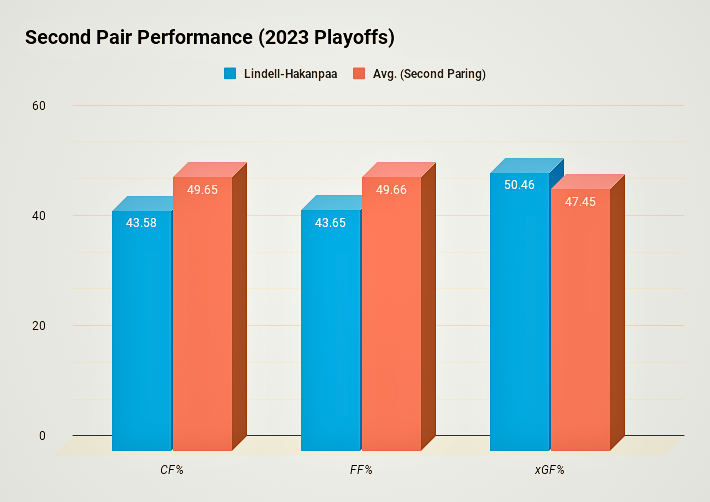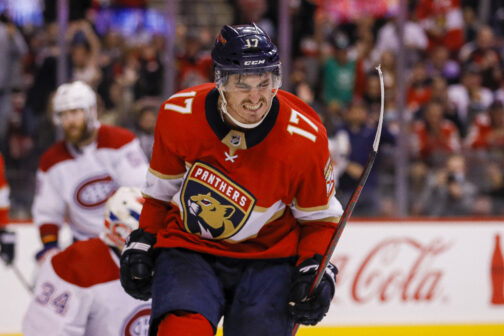The Stars’ 2023 postseason run was as memorable as it was off-putting. With a mix of many great performances along with performances that are better off forgotten, there’s a lot to unpack. But none of that should get in the way of the problem that’ll require all of Jim Nill’s attention during the offseason: fixing the blueline. This is a blueline that used to boast a modern-day Norris Trophy candidate followed by a former Norris candidate. Now it’s something of a hot mess.
Before getting into what makes the blueline a priority and how to fix it, let’s put a pin in any pie-in-the-sky notions about improving the blueline while keeping the band together. It won’t happen, nor should it. The Stars have $7.3 million in cap space to work with. Per Evolving-Hockey’s contract projections, new deals for Max Domi and Evgenii Dadonov—along with Ty Delleandrea—will cost a collective $7.5 million. That would be money well spent if the Stars weren’t up against the cap, but they are. Both trade deadline additions were excellent. But Nill must choose between keeping the forward depth or upgrading the blueline. The answer is the latter, and it always was.
Because you’re all thinking what I’m thinking, and we’ve both been thinking it for a while, let’s cut to the chase: any blueline improvement starts with buying out Ryan Suter. Even ignoring his costly mistake in Game 2, Suter paired with Miro Heiskanen to produce the lowest expected goal share of Dallas’ three postseason duos. Elliotte Friedman brought up the buyout discussion on 32 Thoughts and offered the tired counterargument to doing otherwise: who’s gonna replace those minutes? Well, why not Colin Miller, the guy who played next to Heiskanen all year? In their share of shot attempts (55 to 52 percent) and expected goal share (54 to 49 percent), Heiskanen-Miller was superior analytically, and it kept Heiskanen on his strong side, where he always has been better able to create offense.
This isn’t even getting into how Suter eats into what unquestionably should be Thomas Harley’s minutes on the second power-play unit. Buying out Suter would save $2.8 million in cap space for the next two years. As Suter fades, he’ll just be a heavier anchor for Heiskanen to haul around on his weak side. I know there’s a level of nuance I might be ignoring given Suter’s playoff performance (at least in the first two series), but nuance is overrated in the context of overwhelming evidence. It’s time to cut the cord, full stop.
There’s just one not-so-small problem: Parting ways with Suter wouldn’t address Dallas’ biggest blueline problem. Every team in the Final Four boasts players who didn’t just stand in the shadow of their number one. Behind Alex Pietrangelo is Shea Theodore. Behind Jacob Slavvin is Brett Pesce. Behind Aaron Ekblad is the unheralded but quietly elite Gustav Forsling. These aren’t just defensemen who can play tough minutes; they’re defensemen who can control those minutes. The Stars have nowhere near that kind of talent, which is why Esa Lindell and Jani Hakanpaa were brutalized in the playoffs. Hakanpaa’s performance was palatable given his cost, but Lindell’s performance is a harder conversation. It raises questions about whether his $5.8 million annual salary is becoming an albatross. But that’s just where this conversation starts.
I want to hang around on this point because improving the second defensive pair is more important than any discussion about a Suter buyout, or trying to keep Domi and Dadonov. Neither Lindell nor Hakanpaa will ever be point producers, so it’s important to find out if they were effective in other areas. Unfortunately, they weren’t.
Below is their shot share (CF%), unblocked shot share (FF%), and expected goal share (xGF%) compared to the average second-pairing performance in the 2023 playoffs.
These two were trounced—hard. When opponents are so much faster in the neutral zone, two players who only know how to exit the zone with board rims and dump-outs will just allow them to reload. And that’s exactly what happened. Without being able to drive play, Lindell and Hakanpaa controlled shot quality relatively well, but they were stuck in a groundhog’s day loop of having to control that shot quality instead of helping Dallas generate anything going the other way. Per Corey Sznajder’s tracking data, Lindell and Hakanpaa were only able to exit out of zone with possession 34 and 27 percent of the time, respectively. In 19 playoff games they finished a collective minus-13, combined for a meager five points, and were outshot 112-72. Their regular-season performance was no different; they were able to tread above water in keeping shot quality down, but not shot quantity. That’s 20 minutes a night that Dallas couldn’t gain territory from its backend, and it proved fatal.
I understand why Stars fans don’t want to let go of Domi and Dadonov, two players who became fan favorites. But Dallas might have its next Domi and Dadonov in Logan Stankoven and Mavrik Bourque. Granted, improving the team on the hopes and prayers of two rookie performances is not exactly good engineering, but it’s worth remembering that Domi and Dadonov were both X-factors themselves.
I can see why nothing may happen, though. The market makes improving the blueline tricky. Let’s start with the most likely solution to the blueline problem: the unrestricted free agent class. It’s not exactly brimming with top-tier talent, but there are some options. Former Devil Damon Severson is a fantastic, play-driving defenseman. He’s also a right shot, which would be perfect next to Heiskanen or as an element for the second pair. If Suter is bought out, Dallas will have about $10 million to work with. Could Nill buy his way into a better blueline? In point of fact, yes. Below is a list of defensemen, along with their projected term and cap, I believe would be good additions.

Adding John Klingberg and Scott Mayfield could be exactly what Dallas needs: reunite Klingberg with Lindell, and keep Heiskanen on his strong side with a proven shutdown defender in Mayfield. Mayfield stands out more for his potential to play next to Harley, though. It’s important not to jump the gun on Harley as top-four material, but there is no greater litmus test for a young defender than the high stakes of playoff hockey. Harley routinely passed that test. If the Stars were to groom him into a top-four role—or have the stomach to put Lindell’s bloated contract onto the third pair—they would essentially solve their top-four problem by elevating Harley’s role.
That said, I’m more into the concept of a trade. Thanks to the Matthew Tkachuk deal, there seems to be an appetite for frisky moves, according to insiders. Calgary’s Chris Tanev has one year left on his $4.5 million deal. The Flames’ blueline is loaded, and they won’t be pushing their chips in next season. He’d be perfect next to Heiskanen or Harley. Rumors have swirled in the past about the Blues’ Colton Parayko. He and Tanev have strong defensive shot impacts that could more effectively transition Harley into the top four. The asterisk there is that Tanev has been injury-prone, and the 30-year-old Parayko, who is on the downside of his career, is signed until 2030.
I’d be remiss if I didn’t talk about Nils Lundkvist, who I believe is a really solid young player. His gifts in the offensive zone are impressive, and Harley’s presence alone shouldn’t be what makes Lundkvist obsolete. When all was said and done, Pete DeBoer had positive things to say about him. But we saw what happened when it got down to the marrow: not only was Lundkvist an afterthought, but Suter’s role got even bigger. Lundkvist’s role will always hang in the balance as long as he teeters on the bottom pair. If so, Nill has to decide now if he made a mistake, or if the long game is still the end game.
Whatever the case, Nill has to work through a maze of challenges. Suter, Lindell, Lundkvist, Hakanpaa, and Miller all require long conversations. Nill has never had it in him to move out contracts for the sake of expediency. He wants players to see the end of their deals, and that has earned him an excellent quality reputation. But that’s also why I’m not sold on the narrative that the Stars will only get better, that they deserved better, or that they’re primed for another deep run.
Not because the roster isn’t good enough, but because progress isn’t linear. That’s why this year felt like a lost opportunity to me. The Stars have one more year to get it right—one year to take advantage of the Joe Pavelski window (and did his absence ever highlight that), one year to get truly aggressive and fix what so desperately needs fixing. Past playoff runs offer no solace or guarantees of future success. Nothing about Dallas getting better next season makes sense if the blueline doesn’t improve. Nothing.
Get the ItList Newsletter
Author







